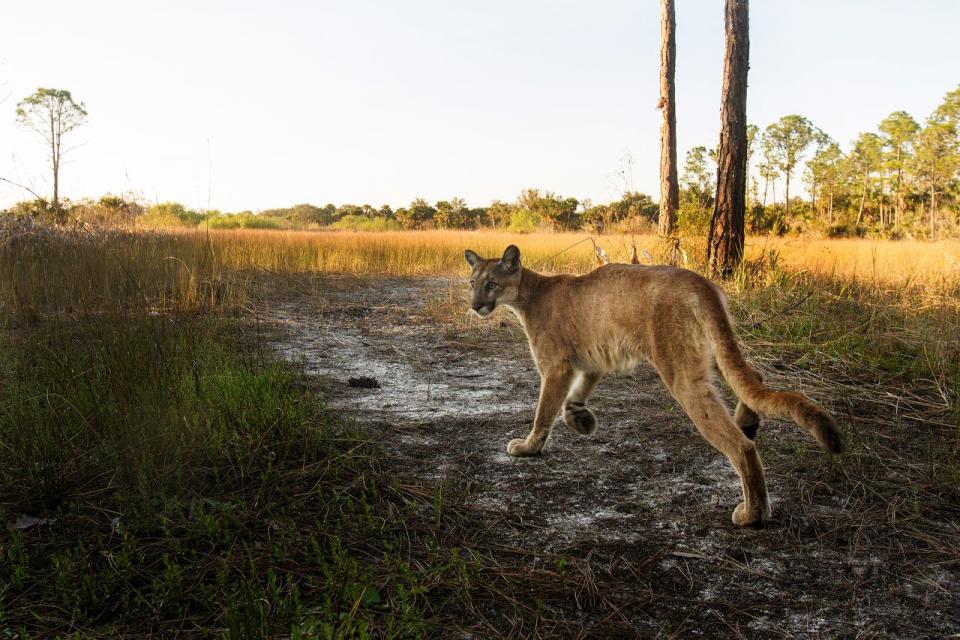Florida panther disease may be caused by harmful algae blooms around preserve lands
A disease crippling some Florida panthers and bobcats is causing frustration with Southwest Floridians like Eugene Wordehoff of Marco Island.
Wordehoff is a retired mechanical engineer. He's been studying water quantity and quality reports for several years, and he's come to the conclusion that algae may be responsible for the novel condition affecting these big cats.
He says areas south of the 60,000-acre Corkscrew Regional Ecosystem Watershed, or CREW, and toward Lake Trafford are declining in water levels and increasing in algae cover due to stagnant conditions and hot weather.
"I plotted a map and there was a hypoxic zone (near) CREW, and it didn’t exist 20 years ago according to a county report," Wordehoff said. "I did it by watershed, and there it popped up that right in the center of the county, a dead zone. And then we see the panther reports and they say it’s in that area, and you put two and two together."
A strange new threat to panthers
Feline leukomyelopathy, or FLM, didn't exist 20 years ago, either.
FLM is a type of neurological disease that cripples Florida wild cats and renders them unable to hunt or escape predation.
It was first discovered in 2017, and some panther population measurements suggest the population is plummeting, again.

Wordehoff is no panther biologist, and he's not a hydrologist, either. But he may onto something, according to the latest response from the Florida Fish and Wildlife Conservation Commission, the state agency charged with protecting endangered and threatened species.
"Toxins, including harmful algal toxins, are a primary suspect in our investigation of FLM," said Mark Cunningham, FWC's lead veterinarian, in an email. "Although FLM cases so far have tested negative for a suite of algal toxins including cylindrospermopsin, microcystins, anatoxin, BMAA, and others, we are continuing to pursue testing for additional biotoxins."
In other words, blue-green algae and other harmful algae outbreaks could still be responsible for the neurological disorder.
More: Panther status change could open South Florida preserve lands to more development
Algae or something else in the water may be to blame for illness
FWC veterinarians have said for months that they believe something in the water is causing the disease.
Harmful algae blooms have been more common across the Sunshine State in recent years as water quality in many systems has declined in the past few decades, according to water quality reports and the number and severity of algae blooms that have been documented here.
Cunningham said whatever is causing FLM in panthers and bobcats is being found across the state, although virtually all panther cases have occurred south of Lake Okeechobee.
"The distribution of FLM cases may provide clues to a possible cause, and most cases do occur in Southwest Florida," Cunningham said. "However, since FLM has only been documented in bobcats and panthers, the distribution of FLM is likely skewed somewhat by the geographic range of panthers (primarily Southwest Florida)."
The disease is showing up in bobcats in areas where panthers aren't typically found, which means the conditions that are causing the disease are not isolated to Southwest Florida.
"Nevertheless, FLM in both bobcats and panthers has been documented from Collier County north to Alachua County and east to Brevard County and in a variety of habitat types, ranging from relatively intact wilderness areas in Big Cypress National Preserve and Fakahatchee Strand to urban/suburban neighborhoods in Naples, Punta Gorda, Tampa/Riverside, and elsewhere," Cunningham said.
More: Toxic blue-green algae bloom spreads to Cape Coral; testing equipment being placed
Panther road kills have fallen dramatically in the past 18 months to two years.
Only six Florida panthers have been hit and killed by cars so far this year, according to FWC records. Twenty panther deaths were documented by this point in 2022, with 19 being documented through the same period in 2021.
FWC panther biologists have used the number of road kills as a type of measuring stick for the panther population, with the theory that more road kills mean the overall population is growing.
If that theory is correct, does fewer road kills mean there are fewer cats roaming Southwest Florida?
“Researchers still don’t know what’s causing the disease, how it’s transmitted, and how many panthers in the wild are affected,” said Matthew Schwartz, director of South Florida Wildlands Association.
Connect with this reporter: Chad Gillis on Facebook.
This article originally appeared on Fort Myers News-Press: FWC: Panther disease possibly related to water quality, algae blooms

